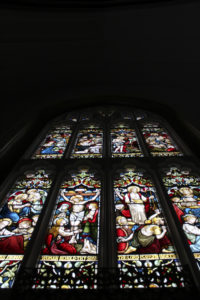I looked through the photos I took on the shoot and using the flag tool and the p and x keys I quickly selected any images that I wanted to take further, this also gave me the opportunity to hide any images which were technically inaccurate or that I didn’t like. After doing this I was left with around 100/350 images that had been flagged, I then went through these to narrow the selection down by giving each image a star rating. finally I went through the 4 and 5 star photos and highlighted my favourite 20 images in green.

Lewis Bush, a professional photographer helping us with this project, came into our lesson and sat down with each of us helping us to find a theme in our chosen 20 images which we could develop further to help our images look more unique. we discussed how I had taken a lot of photos in and around churches and that a common theme in my images could be religious symbolism. I had photos of the church structures, the people involved with them and interesting scenes I found within them.
After Talking to Lewis I refined my selection further so that I had a series of 6-10 images which had more in common and could lead to further development in my project. I quickly edited these photos in Lightroom by balance colours and highlight and shadows, I also slightly crop and straiten them if they needed it.



From this I am going to plan a second shoot where I focus in more on my theme and try to develop and link and style in my photos. I am also interested in experimenting using flash and channeling light so that only parts of the frame are illuminated, I did this this a few of my photos from the first shoot and really liked how they turned out.
Daily Archives: July 1, 2018
Filters
Photo Archives – Artist Research
Percy Dunham
Dunham was Jersey’s first photojournalist and for a very short period of time in1913 and 1914, he worked for Jersey Illustrated Weekly and then the Morning News, the main competitor for many years for the Evening Post (now known as the Jersey Evening Post and the island’s top daily newspaper).
In the years leading up to the First World War the Evening Post had not embraced the new processes for including photographs in their newspapers, therefore, the illustrated Weekly and the Morning News were the pioneers of photojournalism in Jersey, along with other short-lived publications such as The Jerseyman.
The early photographs were largely portraits or promotional images to keep advertisers happy, but then, in 1913, along came Percy Robert Dunham who worked simultaneously for the Illustrated Weekly and the Morning News.
Photojournalism at the time didn’t have many set rules or definitions, Percy Dunham would document anything and everything he felt was significant at the time.

Photojournalism at the time didn’t have many set rules or definitions, Percy Dunham would document anything and everything he felt was significant at the time.
Percy Dunham’s documentation photography is very natural, other than in group portraits, he photographs everything exactly how he saw it. Working for two newspapers meant he spent a lot of his time tied to his camera, and his skill is very evident in the photographs. The photos capture jersey in its purest and most natural form- when I’m taking photographs I want to do the same. Much like Percy Robert Dunham, I want to photograph people on their natural environment; this could be environmental portraits or just street photography.







